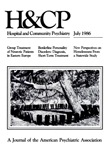Profiles of Difficult Psychiatric Hospital Patients
Abstract
In a study of 127 long-term psychiatric hospital patients perceived as difficult to treat, investigators used hierarchical grouping analysis to differentiate ten profile groups of patients. The groups are based on four dimensions or clusters of characteristics previously derived by factor analysis: withdrawn psychoticism, severe character pathology, suicidal-depressed behavior, and violence-agitation. The ten profile groups are described and are related to staff ratings of overall treatment difficulty, prognosis, sex, diagnosis, and other variables. The main conclusion is that treatment difficulty stems in large part from the compounding of different dimensions of severe psychopathology. Thus a pansymptomatic group, with high scores on all four dimensions, ranks highest in overall treatment difficulty.
Access content
To read the fulltext, please use one of the options below to sign in or purchase access.- Personal login
- Institutional Login
- Sign in via OpenAthens
- Register for access
-
Please login/register if you wish to pair your device and check access availability.
Not a subscriber?
PsychiatryOnline subscription options offer access to the DSM-5 library, books, journals, CME, and patient resources. This all-in-one virtual library provides psychiatrists and mental health professionals with key resources for diagnosis, treatment, research, and professional development.
Need more help? PsychiatryOnline Customer Service may be reached by emailing [email protected] or by calling 800-368-5777 (in the U.S.) or 703-907-7322 (outside the U.S.).



